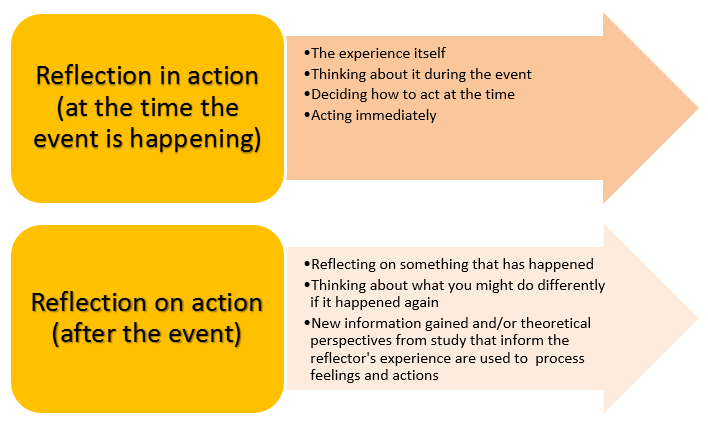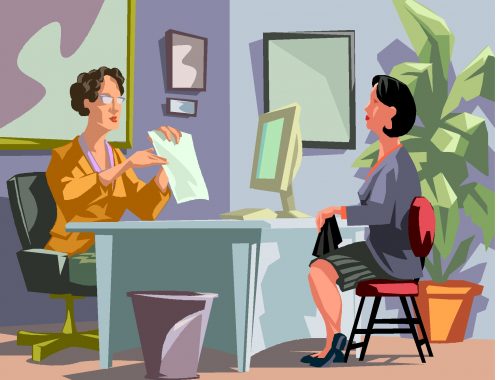Simulated Interviews
An interview is often seen as a stressful situation, prompting anxiety and nervousness. Martin John Yate defines an interview as “a two-way discussion designed to help the interviewer learn more about you, your background, and your abilities, and to help you learn more about the company and the job you are applying for” (2015: 24). Thinking of it in these terms, the dreaded words ‘we’d like to bring you in for an interview’ can alternatively provide connotations of clarity, reassurance, and trust. The employer becomes less a judgemental barrier in the way of your career success but rather a helpful figure simply working out if you would be the right fit. This is the mindset I adopted when going into these simulated interviews.

I undertook an interview for a shadowing director position at Blumhouse. This post will reflect on my experience as both an interviewee and an interviewer using Schön’s Model of Reflection; a framework for reflecting on experiences and learning from them. This model emphasizes the importance of reflection in the process of learning and professional development along with the relationship between theory and practice. According to Schön, this consistent process of reflection and learning is essential to developing professional expertise hence why this model of reflection is best for evaluating my interview.
“Reflection is the key to unlocking the potential for learning that lies within our professional experiences.”
Donald Schön (1994: 56)
Reflection in Action
- The experience itself
- Thinking about it during the event
- Deciding how to act at the time
- Acting immediately
When walking in I knew my level of confidence had to be visible to my peers.
“The attitude you convey in the interview can often be more important than your skills or qualifications.”
Martin John Yate (2014: 37)
If I sat nervously, shaking a leg or tapping a foot I would be taken less seriously as the panel would be distracted and assuming of my potential shyness. I made sure to sit up straight, still, and with an open body posture. Similarly, communication in interviews is key. Therefore, when I addressed my peers I made sure to speak clearly, politely, and confidently. I remember thinking the people before me may be judging me for a job, however, that doesn’t make them higher than me; we’re all humans. I figured most of the time people are just as conscious of you as you are of them. This calmed me down.
The dreaded ‘tell me about yourself’ question came next. However, I was prepared. I recited my short monologue consisting of my personal background, my non-related work experience, and my relevant work experience. Feeling relatively confident, I also added a short line at the end about where I’d like to be in the future. After this answer, I reassured myself that I could get through this!
I knew my research beforehand would be one of the most critical aspects of this simulated interview. As Martin John Yate writes, “the more research you do, the more you’ll be able to show the interviewer that you’re a good fit for the company” (2014: 23). Therefore, when asked about the production company I was applying for I felt confident enough in my preparation that I was able to seem enthusiastic, knowledgable, and like a part of the team already.
Next, I was asked a ‘tell us about a time when…’ question. I had dreaded this question slightly. I had made myself aware beforehand of the STAR technique.

“The STAR technique is a fantastic way to answer behavioral questions.”
Richard Ellis (2015: 87)
Even though I knew to use this technique I was well aware I had applied for a creative storytelling position, therefore, a lot was resting on my ability to tell a personal story on the spot. I took a moment to think of an instance, keeping plaguing thoughts of nervousness at bay. As soon as I started with S I found it hard to think about the technique whilst talking to the interviewer. Nevertheless, I got through it. My answer flowed, I took relaxed pauses, and I keep cool under the pressure.
Reflection on Action
- Reflecting on something that has happened.
- Thinking about what you might do differently if it happened again.
- New information gained
Firstly, sitting as an interviewer, as well as an interviewee, gave me a great opportunity to reflect on the other side of the fence. I understand now that it’s almost as nerve-wracking coming up with questions and asking them as it is to come up with the answers. Similarly, in order to give feedback I had to take note of small details such as body language, choice of words etc. This allows me in my next interview to put myself into the mindset of the interviewer making the experience less daunting and forcing me into thinking purposely about my body language, facial expressions, and choice of words.
Secondly, I would like to reflect on the feedback given to me by my peers. They noted that I used STAR very effectively. Reading this gave me a lot more faith in my ability to tell a story on the spot. I didn’t need to worry about which letter I was at or what I was going to say next as I now understand the progression is fairly natural. They also mentioned that I always related back to the question and to the job. I made sure to keep my answers on the topic by using keywords that were used in the question asked. Therefore, the fact that they noticed this gives me confidence that this was not in fact robotic but rather professional. If I had the chance to do this interview again I would research more about the company. This was the only downfall in my feedback sheet and I honestly can say that I felt this too. I understand now it is not enough just to know vague descriptions rather it is much better to know precise details in order to impress the employer and have them see you as a team member already.
Bibliography
Eatough, Erin. (2022) “How to use the STAR interview methods for success.” Better up. Accessed February 15, 2022. https://www.betterup.com/blog/star-interview-method
Ellis, R.T. (2015) Interview skills: from both sides of the fence CreateSpace Independent Publishing Platform.
Schön, Donald A. (1994) The Reflective Practitioner: How Professionals Think in Action, Taylor & Francis Group.
Yate, M.J. (2014) Great answers to tough interview questions. London: Kogan Page.
You May Also Like

Job Interviews: Selling Yourself For A Pay Cheque
24 February 2023
The World of Theatre upon Reflection
30 November 2022
